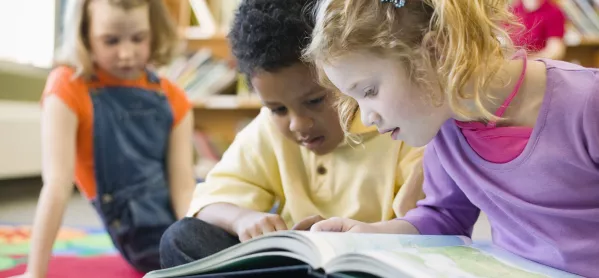What EYFS teachers need to know about shared reading
Share
What EYFS teachers need to know about shared reading
Before children learn how to read in school, books and shared reading experiences are enjoyed by many children. Shared book reading is also an important language experience, which offers many opportunities for learning words.
But what kind of picture books best help pre-schoolers to learn new words?
Research by Dr Zoe Flack and Dr Jessica Horst aimed to investigate this by analysing shared book reading with three-and-a-half-year-olds. In their study, an adult read a story out loud to each child individually, while showing the book’s pages to the child.
Read more: How to teach reading skills without books
From the magazine: Being an introvert at school is a good thing
Listen: Why we’re doing too much, too young in education
The idea was to emulate how a teacher might show a picture book during class reading activities (rather than approximating a shared reading experience between parent and child).
One page or two?
Flack and Horst were interested in two things. First, they wanted to know whether word learning was better with one illustration or two.
Some children saw one page of illustrated text and one blank page. Other children saw two pages of illustrated text, side by side.
The researchers found that the children who saw one illustrated page learned more words than the children who saw two illustrated pages.
This suggests that learning is better when children encounter less information at once, and when there is less potential for distraction from irrelevant information.
Flack and Horst also wanted to know whether this difference would be reduced when children’s attention was directed to the relevant information. So, they compared children who saw two illustrated pages to another group.
The new group of children saw the same two illustrated pages but the adult reading to them made a swiping gesture to indicate the relevant illustrated page. Learning was better with the gesture, showing that any disadvantage of having distracting information can be overcome by directing children’s attention to the relevant information on the pages of a book.
Less is more
What does this mean for the classroom? This study shows that preschool children can only process a certain amount of information at once.
Books tend to include lots of information. If we want children to learn then it is important that they can focus on what is relevant. Teachers can do this in two ways.
One way is to use books in the classroom that have fewer illustrations on the pages.
Another way is to produce helpful hand gestures that offer children guidance for where to look.
It is worth noting that while Flack and Horst’s study tried to mimic the way a teacher might present a story, shared reading was between an adult and one child, rather than a group of children. Group reading will present other challenges (eg children might distract each other).
The authors explain their findings in terms of cognitive load theory, stating that “extraneous information can prevent optimal learning”.
Clean and clear
They point to wider implications for the classroom - that learning should be improved if irrelevant visual information is avoided. So, less (on the wall) may be more, resonating with a general movement in many classes to keep wall decoration to a minimum.
This may be particularly important with children with special educational needs, who might be more easily distracted. The study also points to the importance of using gesture to guide children’s attention to important information in the classroom.
Flack and Horst’s research links to other work at Royal Holloway that we are involved in. Specifically, working in the language and reading acquisition (LARA) lab with Dr Jeanne Shinskey and Dr Suzanne Aussems in the baby lab, we are engaging in a study that will investigate how one-year-olds learn new words during shared reading activities with parents.
The project, funded by the Nuffield Foundation, will investigate whether learning is affected by certain types of pictures in books (eg photos) and by features like texture.
The results could help build to the growing understanding of the best ways to help children’s reading and language development from a young age.
More information about this project and other research ongoing in Royal Holloway’s baby lab can be found online or via Twitter.
Dr Jessie Ricketts is a reader (associate professor) at Royal Holloway, University of London. She researches spoken language and reading development in children and adolescents. Dr Suzanne Aussems is a postdoctoral researcher working with Jessie and Dr Jeanne Shinskey on a Nuffield-funded project investigating what infants learn from picture books
